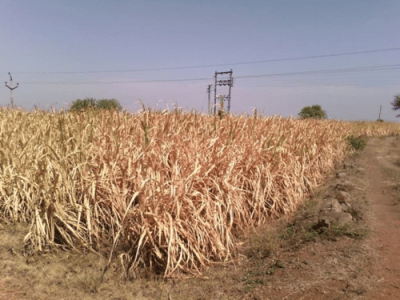Indians are good at finding a scapegoat for all their problems. Sugarcane seems to be the latest for severe drought in Maharashtra and northern Karnataka. Here are two scenarios – one that blames the sugar barons for drought and the other arguing that it’s the irrigation practices, not sugarcane to blame. Both blame it on rank disdain and criminal manipulation by politicians of Maharashtra for the last many decades. Will they at least relent now?
Last year, Maharashtra’s average rainfall was around 1,300 mm, which was more than the national average of 1,100 mm. Some areas, like the Konkan region, received more than 3,000 mm of rainfall. Marathwada received 882 mm, while Vidarbha had 1,034 mm of rain. Thousands of crores of rupees have been spent on irrigation and building dams in Maharashtra, but critical measures for water conservation, drip irrigation or rejuvenating ground water are rarely done. It’s clear that sugar barons in Maharashtra don’t believe in these practices as long as water and power are nearly free and hence earn the right to misuse them.
Despite drought like conditions in the state in the last few years there have been an increase in the number of sugar cooperatives. Maharashtra has over 205 sugar cooperatives and 80 privately owned sugar mills. A recent Indian Express report observes that: “Though, strictly speaking, these mills are private, in many cases, their promoters chair cooperative mills as well. In fact, it is a popular pastime of politicians in Maharashtra to make state-funded sugar cooperatives sick, and then convert them into private ones. Water misuse is just collateral damage.”
It’s ironic that rain deficient Maharashtra produces second largest sugarcane in India after Uttar Pradesh where River Ganga and many of its tributaries flow. Official records show how just about 4% of agriculture land is under sugarcane but uses up as much as 71.5% of irrigated water, including that from wells. “This is not a revelation. The state always knew this. But it never thought of putting a stop to the mushrooming of sugar mills because they are either owned or controlled by the state’s politicians. Any politician worth his name in Maharashtra has to have at least one sugar mill to support his or her political empire. The rule applies to all parties across all regions, including the most drought-prone, Marathwada,” the report observes. 20 new sugar factories came up in the last 3 years even while villages were in distress.
Counter-point
Sugarcane requires 2,100-2,200 mm of water, more than the 1,400 mm or so for paddy, 900 mm for cotton,
600 mm for jowar (sorghum) and arhar (pigeon-pea), 550 mm for wheat, and under 500 mm for soyabean and chana (chickpea). But then, sugarcane grows over 365 days, as against the 180 days of cotton and arhar, 130 days of paddy and wheat, 110 days of jowar and chana, and 100 days of soyabean. Besides, even the best Punjab farmer can harvest only six tonnes of wheat and nine tonnes of paddy per hectare, whereas cane yields rarely go below 40 tonnes, while averaging 80 tonnes in Maharashtra. So the argument is sugarcane consumes less water on a per-day basis, and even less for every unit weight of biomass produced.
Sugarcane farmer doesn’t merely grow cane stalks. For every 80 tonnes of cane produced from a hectare, an additional 15-16 tonnes of green ‘tops’ also get harvested. These green top leaves — roughly 20% over and above the millable cane weight — meet much of the fodder needs of his buffaloes and cattle during the crushing season from November to April. The water being used for cultivating sugarcane, thus, also goes towards production of fodder, which the farmer would otherwise have had to grow separately.
Sugarcane bashers say it takes 2,000-odd litres of water to produce one kg of sugar. But they won’t say that this water is consumed over 12 months, or that it goes towards production of fodder, electricity and alcohol as well. And if one were to also add that the mills themselves consume no additional water or electricity — they are surplus in both — it would virtually mean sugarcane’s water use should be seen differently.
Another incisive report in the Indian Express recently notes that sugar accumulation in the cane takes place only in last 90-100 days of ripening and maturation. The crop’s 365-day duration also covers germination (40-45 days), tillering (springing of stems from the parent shoot: 90-100 days) and grand growth (development of millable canes from tillers: 110-120 days). Much of the water consumption happens in the tillering and grand growth phases that precede sucrose accumulation. “This only reinforces the fact that this is primarily a biomass-cum-energy crop, with sugar only one of its constituents,” the report noted.
Should Marathwada which receives an average annual rainfall of slightly over 820 mm, should grow cane at all? It’s a fact that sugarcane cultivation is about 2 lakh hectares compared to 70 lakh hectares of cropped area. So the pro sugarcane lobby says drought is because of failure of monsoon in the last three years.
Whether the pro or anti sugarcane lobby is right or wrong is less important. This year’s drought should result in compulsory drip irrigation of all crops – supposed to yield one third more – and make flooding the fields with irrigated water a criminal offence. “With drip irrigation and judicious use of canal water, it should be possible for even Marathwada’s farmers to realize the enormous food, energy, and fodder potential offered by a most versatile crop.”
Unlike the droughts a decade ago, Sunita Narain, Director of Centre for Science & Environment, says this year’s drought is manmade – gross mismanagement of water resources and criminal negligence of conservation. She says, it also raises hope that if we put our heads together, we can manage it better in the future.
Experts warn that if corrective steps are not taken quickly, in the next two decades, the Marathwada region will become Maharashtra’s first desert.
Bitter Sweet
• Sugar barons responsible for drought in Maharashtra
• Sugarcane uses 70% of irrigated water with only 2% cropped area
• Maharashtra is second in sugarcane cultivation even when it does not have large rivers like UP to support
• Sugarcane is an energy, fodder, biomass crop with sugar as a byproduct
• It’s a 365 days crop with least water use per day
• Only drip irrigation is the answer
• Make flood irrigation of sugarcane and paddy a criminal offence







